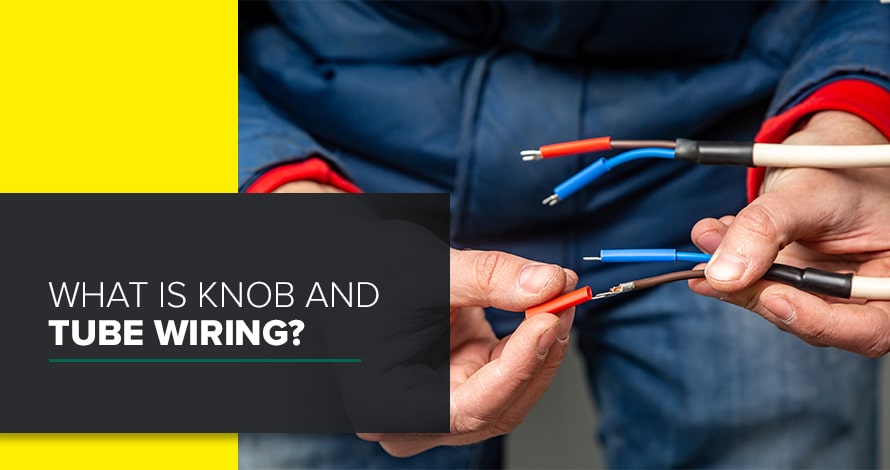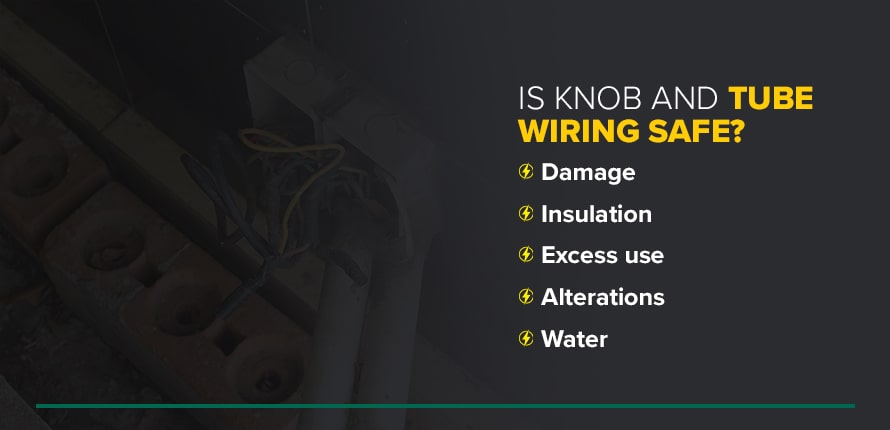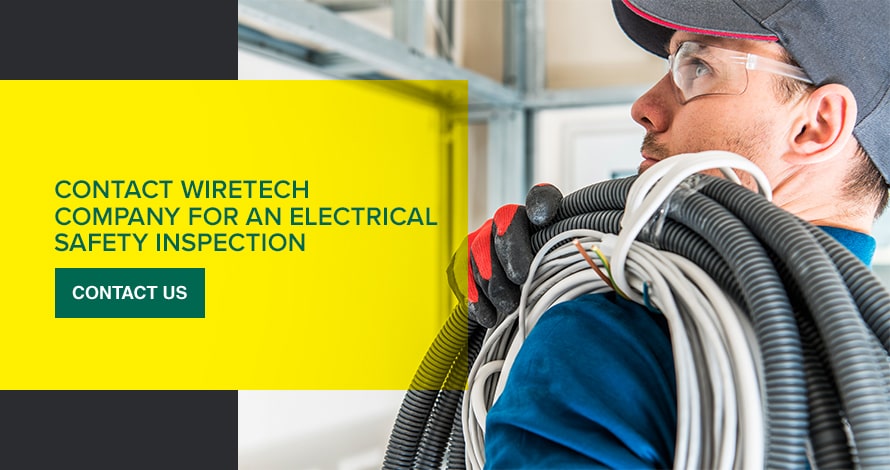
Electrical wiring is an essential component of any modern home. Without functional wiring, occupants are unable to use electricity or electrical appliances, such as computers or washing machines. Maintaining and updating your wiring system when necessary is essential for keeping electrical function throughout your home.
As with any invention, electrical wiring systems have evolved over time. The introduction of new materials and new wiring designs allows for constant innovation, increasing safety and efficiency. However, if the pre-existing system is still functional, many homeowners leave it in place instead of spending time and money updating it. This means that homes still used today can possess wiring systems dating back to the 1950s or further. One such wiring system is knob and tube wiring.
What Does Knob and Tube Wiring Look Like?
Knob and tube wiring is named after the porcelain knobs and tubes that make up the system. Electrical wires are secured to the knobs and threaded through the tubes, which are inserted in the walls and through floor joists. The wires themselves are insulated using rubberized fabric, as opposed to the plastic used in modern wire insulation. This system keeps the wires suspended above the wood.
Unlike modern wiring systems, knob and tube systems don’t have a grounding wire. This means the system can’t accommodate any three-pronged electrical outlets. It also means that the risk of overheating and electrical shocks are much higher than with a modern system. Also, while modern systems have the black-and-white wires combined with the grounding wire inside a single sheathe, the black-and-white wires run separately in a knob and tube system.
While you may be able to see the porcelain tubes, particularly if they’re in the floor joists, knob and tube systems can be hidden inside your walls. Past homeowners will often cover the wiring system, whether intentionally or unintentionally, leaving it hidden unless you drill into the walls or use a small camera to look inside.
When was Knob and Tube Wire Used?
Knob and tube wiring was the primary wiring system used between 1890 and 1910. The introduction of more advanced cable systems, such as flexible armored cables, first-generation sheathed cables and metal conduits, caused knob and tube wiring to fade into obscurity over time. Very few homes built after the 1950s, if any, use knob and tube wiring systems for electricity, and modern projects don’t use it at all.

Is Knob and Tube Wiring Safe?
While knob and tube wiring is an older wiring system and can no longer be used in new buildings, it isn’t inherently unsafe. A well-maintained knob and tube system is perfectly functional, although it won’t accommodate three-pronged electrical outlets. However, there are several potential issues that can make the wiring system more dangerous:
- Damage: Even properly maintained knob and tube systems can get damaged over time. The porcelain can crack, the wires can fray and expose live ends, and the rubberized cloth insulation can dry out and flake off. Knob and tube wires are also prone to stretching and sagging over time. A damaged wiring system is dangerous, so if you have a knob and tube system, it’s important to have it inspected and repaired when necessary.
- Insulation: Knob and tube wiring creates a large amount of heat when in use. If insulation is laid directly over the bare wires, especially blown-in insulation, they don’t have enough room to dissipate the heat. This can lead to them overheating and potentially starting fires.
- Excess use: When knob and tube wiring was in frequent use, many homes didn’t possess the same amount of electrical appliances they use today. Modern homes possess a large number of electric appliances that are often in constant use. These wiring systems aren’t built to handle as much electricity as modern systems, meaning they can overload and overheat easier.
- Alterations: Many issues with knob and tube wiring come from improper fixes. Because the wiring system is so old, the parts necessary for safe repairs are not always available. This can lead to handymen using makeshift fixes, such as splicing the knob and tube wiring into a modern wiring system. These fixes create hazards.
- Water: Since knob and tube wiring systems are ungrounded, they can be extremely dangerous if they come into contact with water. Wet wires can short-circuit, blow fuses and even lead to house fires. This makes them hazardous in rooms such as kitchens or bathrooms, where they’re more likely to be splashed.
If you’re experiencing issues with knob and tube wiring systems, it’s important to consult a trained electrician. Replacing bad circuits or installing protective devices, such as ground fault protection or arc fault protection, can make the system safer. Even if the system is well-maintained, however, having one can cause difficulty when applying for homeowner’s insurance or cause potential homebuyers to turn away. It’s ultimately up to the homeowners to decide if they wish to keep their system or not.
What is the Life Expectancy of Knob and Tube Wiring?
The life expectancy of knob and tube wiring can vary, depending on how well the wiring system has been maintained over the years. Accumulated wear and tear or improper handyman fixes can shorten the wiring’s lifespan. However, even if it’s avoided all other forms of damage, the rubberized fabric used to insulate the wires begins to break down after twenty-five years of use.
Maintaining your knob and tube wiring system is crucial in keeping it safe and functional. A compromised wiring system can lead to a loss of power or start a house fire. If you suspect your system is damaged in any way, consult a professional electrician for a safety inspection and, if necessary, schedule repairs or a wiring system replacement.
Contact WireTech Company for an Electrical Safety Inspection
A functional electrical system isn’t just crucial in maintaining electric function in your home. It’s also crucial in maintaining your home’s safety. A damaged or improperly repaired knob and tube wiring system can lead to loss of power and an increased risk of house fires. In order to keep your system safe and functional, it’s important to have it properly inspected and, if necessary, repaired by a trained electrician.
If you’re looking for a quality electrical safety inspection, call WireTech. Our electricians will examine your home for potential hazards and provide practical solutions with no hidden fees. We offer home safety inspections for Raleigh, Durham, Chapel Hill and the greater Triangle area. Contact us today to find out how we can help keep your home safe and well-lit.

